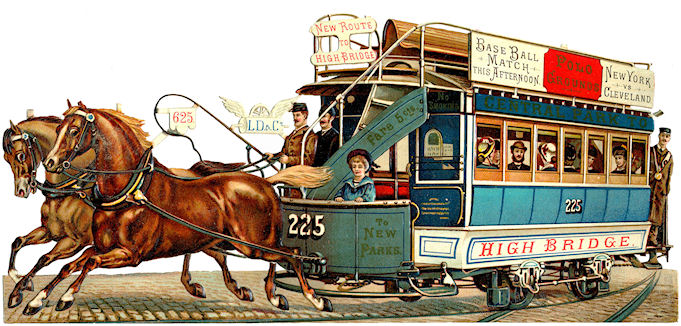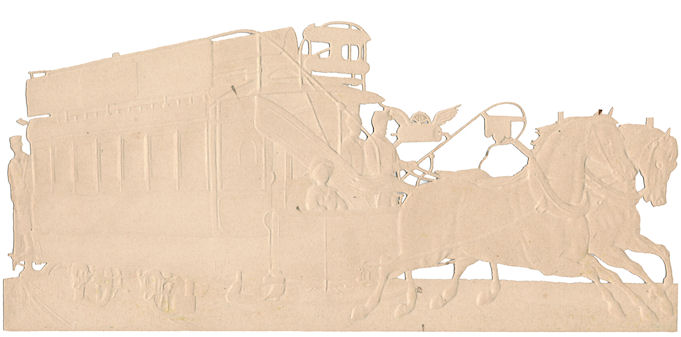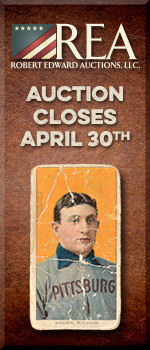2. Featured Card: 1890s Trolley to the Polo Grounds
One of the most elaborate and unique baseball-related advertising cards of the 19th century is displayed below. The highly detailed lithograph measures 11-1/4 inches wide by 5-1/4 inches tall.
As seen on the card, a prominently displayed sign extends the full length of the trolly and promotes a "Base Ball Match This Afternoon" at the Polo Grounds between New York and Cleveland. Other signs on the trolly carriage indicate a "New Route to High Bridge" and state that the fare is 5 cents.

The card is printed on medium heavy stock and has a glossy finish. A view of its back (see below) clearly shows that it is both diecut and embossed. Because some of the diecut detail is cut thin and poorly supported, examples today are often found damaged with some parts (especially the driver's whip) sometimes missing.

Very little is known today about the origins of the card or its producer or distribution. However, it can be reasonably dated to the early 1890s based on the following:
- The New York Giants first full season at Polo Grounds II, located around 155th street near High Bridge and about 35 blocks north of Central Park in midtown Manhattan, was in 1890. The team had earlier played at Polo Grounds I, which was located just across 110th Street from the northeast corner of Central Park.
- The Giants and Cleveland "Spiders" were both members of the National League throughout the 1890s.
- Electric powered street cars began operation in New York City in 1887 and soon replaced horse drawn trolleys (as depicted in the advertising card) on many routes. Thus, the horse-drawn trolley that served the High Bridge Route was likely discontinued by the mid to late 1890s.
The High Bridge Route in Perspective
The High Bridge (destination of the High Bridge trolley) was completed in 1839 as a Roman style aqueduct to carry water over the Harlem River to the residents of Manhattan from a resevoir about 40 miles to the north. The bridge survives today as the oldest bridge connecting to the island of Manhattan. It was re-opened to the public as a footbridge just last year (in June of 2015) and is now listed as a historic landmark.
The adjacent drawing (at top left) shows a view of High Bridge with the Polo Grounds as they existed in the 1890s in the foreground. It was drawn by well known New York artist Joseph Pennell. Note: the middle section of about five stone arches of the original bridge were replaced in 1928 by a single steel span to better facilitate larger boats navigating the Harlem River. The tall structure to the left of the bridge is a water tower built in the 1870s. It is not directly related to the aqueduct system, but was used to provide stable water pressure for residents in upper Manhattan. It is not functional as a water tower today, but survives as a historic landmark.
The photo at top right was recently taken and shows the High Bridge as it exists as a pedestrian footbridge today. As seen in the photo, the High Bridge water tower also survives today as a prominent landmark in upper Manhattan.
The map below the images helps provide geographic perspective and relative locations of the High Bridge, High Bridge water tower and site of the Polo Grounds.
The inset at the lower left corner of the map shows the location of the High Bridge between the burroughs of Manhattan and the Bronx.
Note that the blue line in the map traces the route of the Croton Aqueduct from above the High Bridge into midtown Manhattan and most likely closely parallels the route of the High Bridge trolley. Additional information about the High Bridge and the Croton Aqueduct can be found here.
High Bridge Links to the Earliest Days of Baseball
Coincidentally, one of the engineers that helped in the design and development of the High Bridge was Henry T. Anthony. Collectors and researchers of 19th century baseball memorabilia may also know Anthony as a member of the New York Knickerbockers, one of the first teams to play baseball under rules similar to those used today. The team was first organized in September of 1845.
The photo at left pictures five players of the Knickerbockers team, including Henry Anthony. They are (top row, left to right): Alfred Cartwright (not a member of the team), Alexander Cartwright (often referred to as "the father of baseball") and William Wheaton. (bottom row) Duncan Curry (elected first president of the team), Daniel "Doc" Adams and Henry T. Anthony.
In 1828, Henry Anthony entered Columbia College and graduated with honors four years later. After that, he worked intermittently as a civil engineer at the Erie Railroad, Croton Aqueduct Project, Hudson River Railroad and as a clerk at the Bank of New York.
In 1839 Henry became interested in the new art of photography, which he learned along with his brother Edward. Not long after Edward established a photography firm, Henry joined the firm in 1852 (while still actively playing for the Knickerbockers and serving as the team's treasurer). The E. & H. T. Anthony & Company eventually became the largest distributor and supplier of photographic equipment in the United States during the 19th century. It became the Ansco Company (for Anthony & Scovill) after merging with the camera operations of Scovill Manufacturing Company in 1901, and continued operating under the Ansco name until 1967.
It is also interesting to note that Ansco, named in part after baseball pioneer Henry Anthony, sponsored a 1949 set of Cuban Baseball cards. The set includes a card of "Rifleman" TV star Chuck Connors, who played for the Almendares Base Ball Club of Havana, Cuba at the time.


